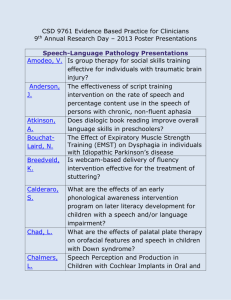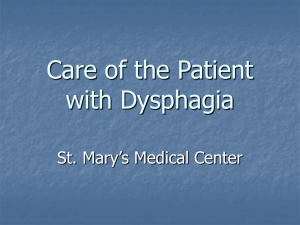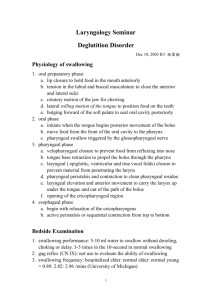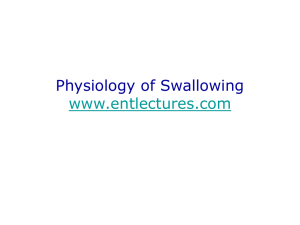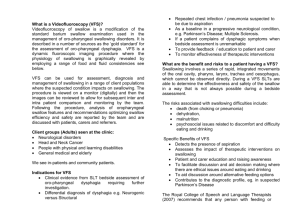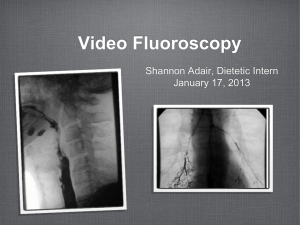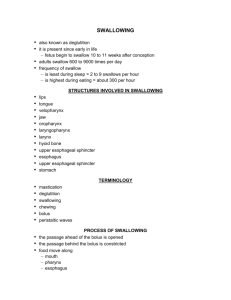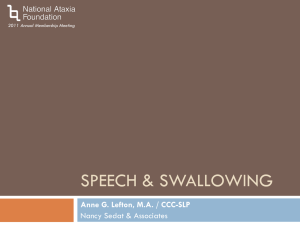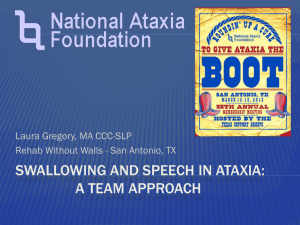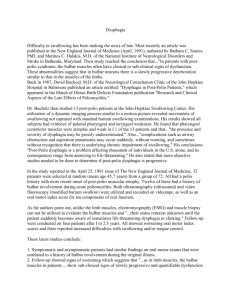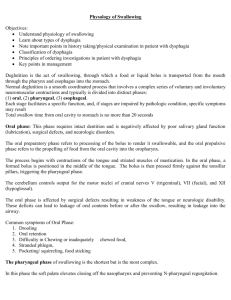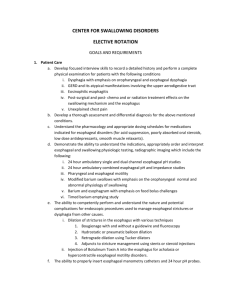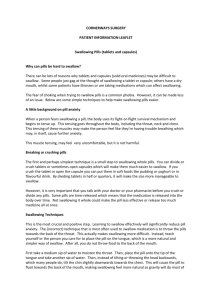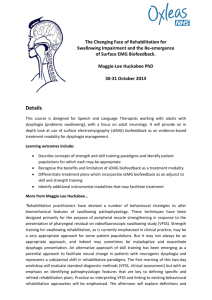File - Scleroderma Association of Manitoba
advertisement
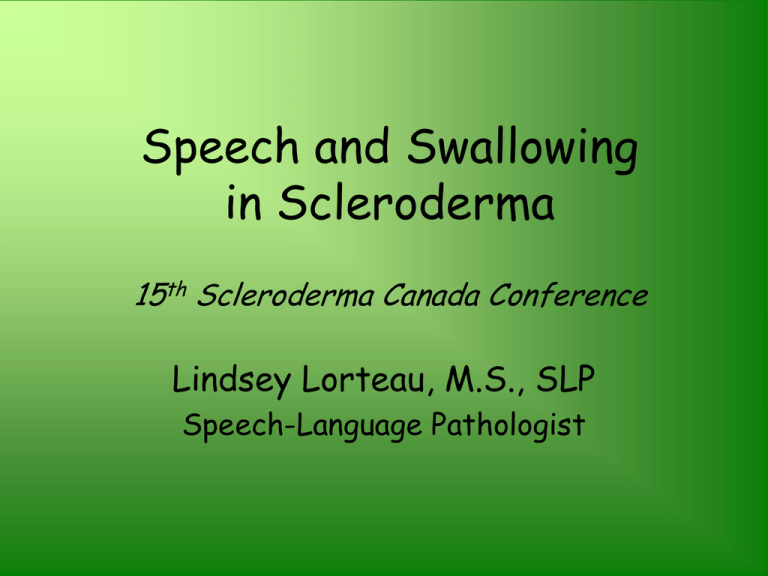
Speech and Swallowing in Scleroderma 15th Scleroderma Canada Conference Lindsey Lorteau, M.S., SLP Speech-Language Pathologist Speech Production • “Normal” Speech – Articulation / Pronunciation – Phonation / Voice – Respiration / Breathing – Resonation / Nasality Speech Problems • Xerostomia (dry mouth, saliva flow), often seen in Sjögren’s syndrome Difficulty pronouncing sounds • Microstomia ( mouth opening) Difficulty pronouncing sounds • Collagen build up Difficulties with voice quality, Breathing issues Speech Management • Stay hydrated! • Use your voice well – be careful, avoid straining your voice • Avoid noisy areas • Speak slowly but naturally • Stay well rested • Consider speech therapy Swallowing Definitions • Dysphagia: disruption of normal swallowing process • Penetration: entry of material to laryngeal vestibule • Aspiration: entry of material to trachea, below level of vocal folds (VF) • Bolus: food after it’s been chewed, ready to swallow • Assessment: Clinical Dysphagia Assessment – Videofluoroscopic Swallow Study (VFSS) – Fiberoptic Endoscopic Evaluation of Swallowing (FEES) Anatomy of Swallow • Oral cavity: Lips, tongue • Nasopharynx – Soft palate, Posterior pharyngeal wall • Pharynx – Laryngeal cartilages – Bone . . . Hyoid, Mandible – Laryngeal muscles • Esophagus Physiology of Swallow • Oral phase – lasts about 1 second • Pharyngeal phase – lasts less than 1 second • Esophageal phase – lasts from 8 - 20 seconds (dependent on bolus consistency) The normal swallow (VFSS) Swallowing Assessment • “he’s choking” • “he swallows fine, he just coughs alot” • “there’s something stuck in my throat” • Usually completed by SLP • May be GI, Dietitian involved Swallowing Assessment cont’d • Clinical signs of aspiration risk • Where is the swallowing problem? – Oral, pharyngeal or esophageal • Indications for Instrumental Exam – Symptoms inconsistent with clinical findings – Contribute to possible medical diagnosis – Determine if dysphagia contributing to nutritional or pulmonary compromise – Safety or efficiency of swallowing is a concern – Guide management Purpose of Swallowing Assessment • Promote good health • Improve quality of life – Ability to enjoy food and beverages – Imposed dietary restrictions – Social nature of eating/drinking • Prevent life-threatening conditions – malnutrition – dehydration – pneumonia Dysphagia & Aspiration Pneumonia (Langmore, 1998) • Colonization (altered oropharyngeal flora) • Aspiration into lungs – Larger volume aspiration – Microaspiration • Host resistance – Pulmonary clearance – Systemic immunologic response • Pneumonia VFSS • Accepted standard for detecting & evaluating swallowing abnormalities • Dynamic view of oral cavity and pharynx, cervical esophagus • Side and Front views • Barium mixed with food/liquid • Clinician judgement Swallowing Problems • Xerostomia difficulties with dry foods, bolus formation/transit • Microstomia difficulties biting, chewing, placing dentures, hygiene • May see pharyngeal issues, including retention, aspiration, and UES incoordination (especially with prominent esophageal dysmotility) Swallowing Problems cont’d • tension for esophageal contractions Poor esophageal motility (lower 2/3), especially for solid foods > liquids • Lower Esophageal Sphincter pressure Reflux (Reflux Esophagitis, LPR) • Esophageal atrophy, fibrosis, strictures Swallowing Problems cont’d • ‘Globus’ sensation – symptoms referred to throat, making you feel like there’s something stuck – Needs further assessment Barium Swallow Examples • Scleroderma esophagus peptic stenosis as seen in a double-contrast examination of the esophagus VFSS Examples • Laryngeal penetration (thick arrow) or tracheal aspiration (thin arrow) may occur as a result of post swallow stasis in the valleculae – See more at: http://www.oralcancerfoundation.org/c omplications/dysphagia.php#sthash.Xy jC166j.dpuf VIDEO • Penetration VIDEO • Aspiration Therapeutic Intervention – – – – – – Exercises Postural changes to alter bolus flow Optimal oral hygiene, saliva substitute Diet modifications Alternative eating Reflux management (conservative, medical, surgical) – Esophageal dilation Resources • Speech-Language & Audiology Canada http://sac-oac.ca/ • Canadian Association of Gastroenterology http://www.cag-acg.org/ • Canadian Digestive Health Foundation http://www.cdhf.ca/ • Dietitians of Canada http://www.dietitians.ca/
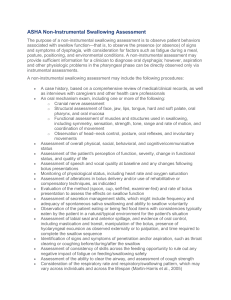

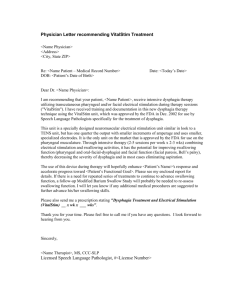
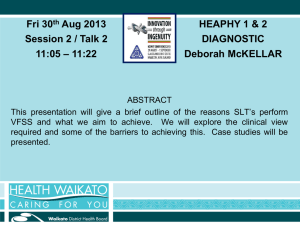
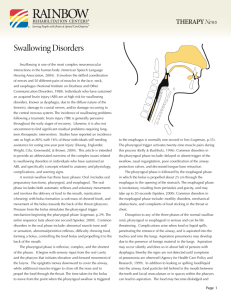
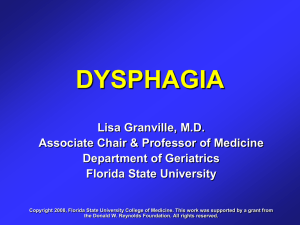
![Dysphagia Webinar, May, 2013[2]](http://s2.studylib.net/store/data/005382560_1-ff5244e89815170fde8b3f907df8b381-300x300.png)
